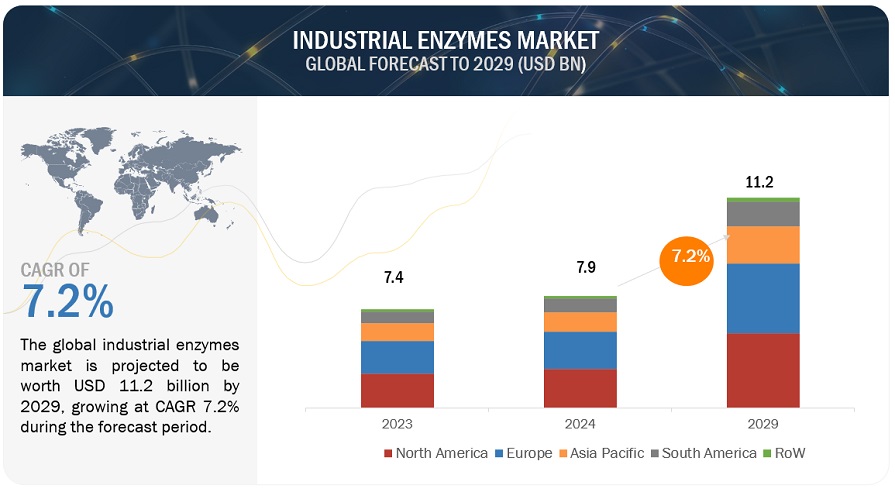The global industrial enzymes market is expected to grow from USD 7.9 billion in 2024 to USD 11.2 billion by 2029, reflecting a CAGR of 7.2% during the forecast period. This growth is largely driven by increasing demand from industries such as food and beverages, biofuel production, and more. Enzymes offer a sustainable alternative to traditional chemical processes, and advancements in biotechnology and protein engineering have expanded their effectiveness and applications. Government support and stringent environmental regulations, like the U.S. Toxic Substances Control Act and the Canadian Environmental Protection Act, further promote the adoption of eco-friendly enzyme technologies. Additionally, the growing consumer preference for clean labels and organic products is boosting the demand for enzymes, as they align with natural and sustainable ingredient requirements. This trend is expected to further enhance the market value of industrial enzymes.

Industrial Enzymes Market Drivers: Switch toward renewable sources of energy to lead to increased consumption of bioethanol
The increasing demand for renewable energy, particularly bioethanol, is significantly driving the industrial enzymes market. This demand is fueled by environmental concerns and a commitment to reducing greenhouse gas emissions. The overexploitation of natural resources and rising air pollution have intensified the focus on sustainable alternatives. Bioethanol, produced through enzymatic hydrolysis, offers a much cleaner option compared to conventional fuels like gasoline. The production process of bioethanol relies on various enzymes, including amylases, cellulases, lipases, and proteases, which means that growth in the bioethanol sector will positively impact the industrial enzymes market. Additionally, government initiatives and policies promoting renewable energy, with ambitious clean energy targets, are further supporting the expansion of the industrial enzymes market.
Industrial Enzymes Market Opportunities: Innovations in technologies and wide industry scope
The industrial enzymes market is poised for significant growth driven by innovative technologies. Advances in bioprocessing allow for the production of enzymes from a diverse range of feedstocks, enhancing sustainability. Furthermore, genomics and metagenomics facilitate the discovery of new enzymes tailored for specific industrial applications, particularly in the degradation of lignocellulosic biomass. Automation and artificial intelligence also play a crucial role by improving efficiency and precision in enzyme production through fermentation processes and optimizing enzyme formulations. Key industry players, such as DSM, are further propelling this growth by innovating low-glycerol yeast technology for bioethanol production, which aims to mitigate the environmental challenges associated with traditional fuels.
Download PDF Brochure:
https://www.marketsandmarkets.com/pdfdownloadNew.asp?id=237327836
What factors contribute to the dominance of food and beverage applications in the industrial enzymes market?
The industrial enzymes market in the food and beverage sector is experiencing rapid growth, driven primarily by increasing consumer demand for natural, sustainable, and healthier food options. Enzymes are appealing to health-conscious buyers because they help preserve natural characteristics while enhancing efficiency in food processing. Additionally, they are crucial in developing new products like plant-based, lactose-free, and gluten-free options, which are gaining popularity as dietary preferences evolve. Enzymes also improve texture, flavor, and shelf life, further fueling their demand. As the food industry becomes more innovative, the significance of enzymes continues to rise, contributing to their remarkable growth in the market.
Asia Pacific Industrial Enzymes Market Poised for Highest CAGR Growth During the Forecast Period.
The industrial enzyme market in the Asia-Pacific region has experienced significant growth, driven by the expanding food and beverage sectors, where enzymes are used to enhance product quality and extend shelf life. Additionally, government initiatives promoting biofuels have increased the use of enzymes in bioethanol production. The region's rapidly growing textile industry, which benefits from the eco-friendly applications of enzymes, also contributes to rising demand. Furthermore, advancements in sustainable agriculture are fueling the adoption of enzymes in farming practices.
Top Industrial Enzymes Companies
The key players in the industrial enzymes market include BASF (Germany), Novozymes (Denmark), DuPont (US), DSM (Netherlands), Associated British Foods plc (UK), Kerry Group plc (Ireland), Advanced Enzyme Technologies (India), Chr. Hansen Holding A/S (Denmark), Amano Enzyme Inc. (Japan) and Megazyme Ltd. (Ireland). These market participants are emphasizing the expansion of their footprint via agreements and partnerships. They maintain a robust presence in North America, Asia Pacific, South America, RoW, and Europe, and they are supported by manufacturing facilities and well-established distribution networks spanning these regions.








